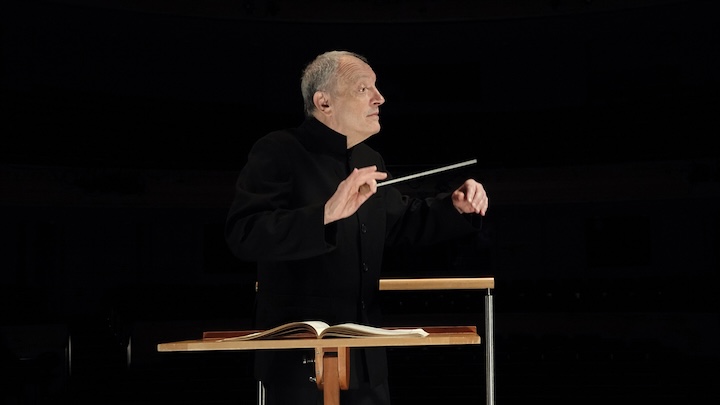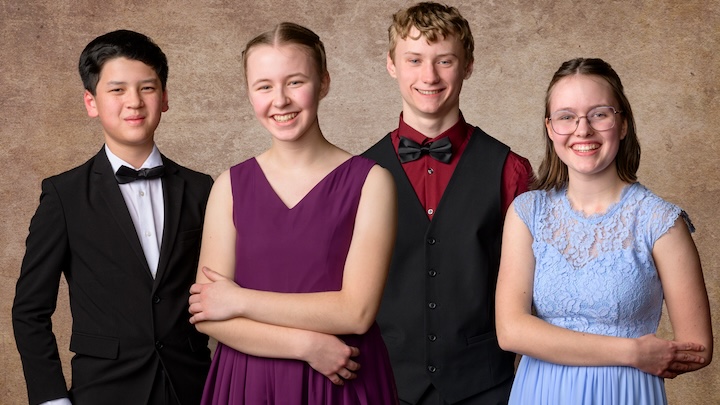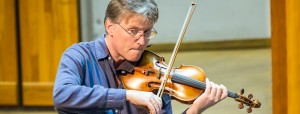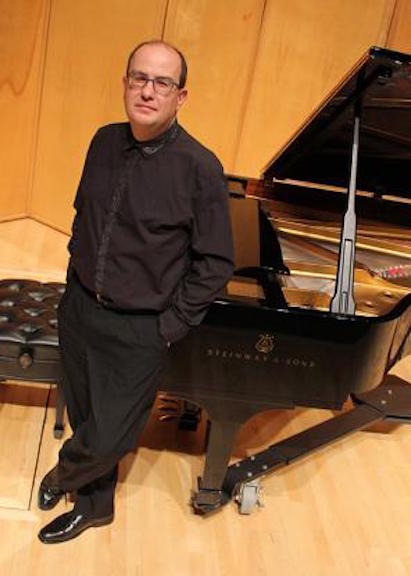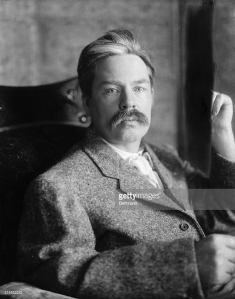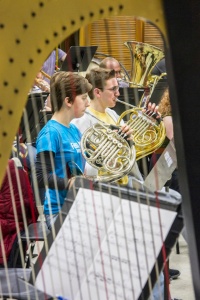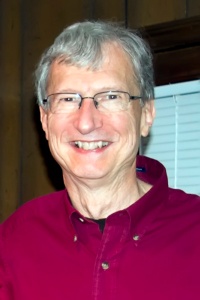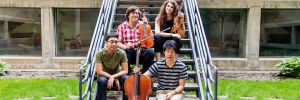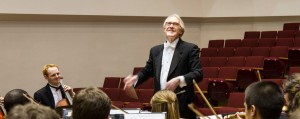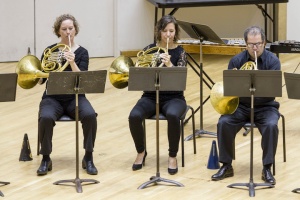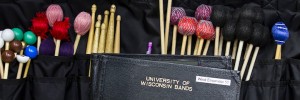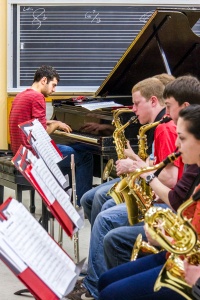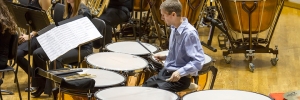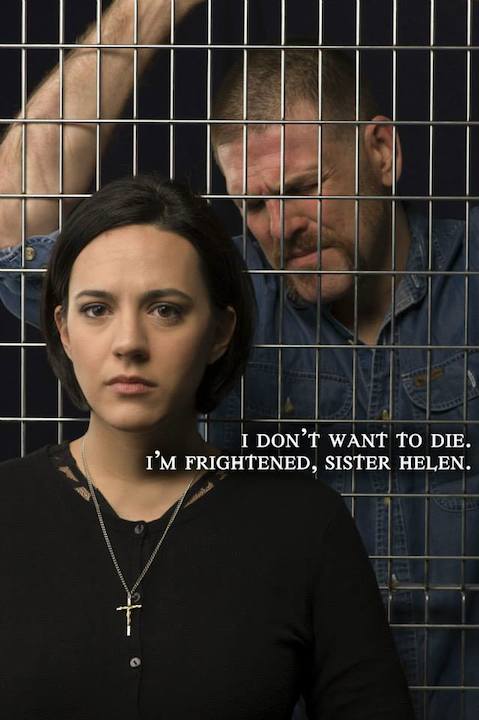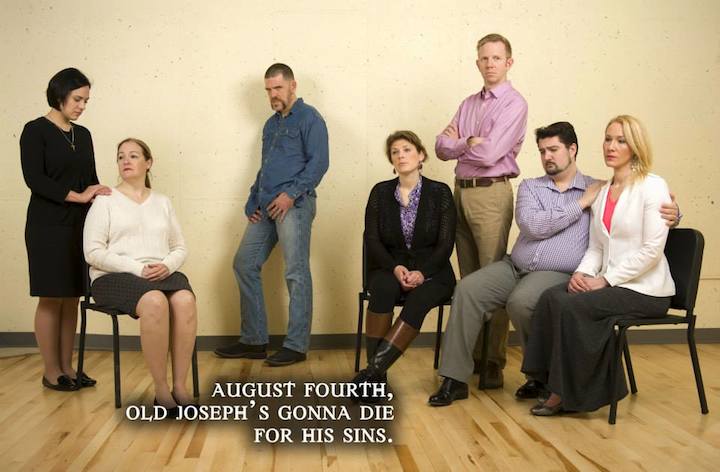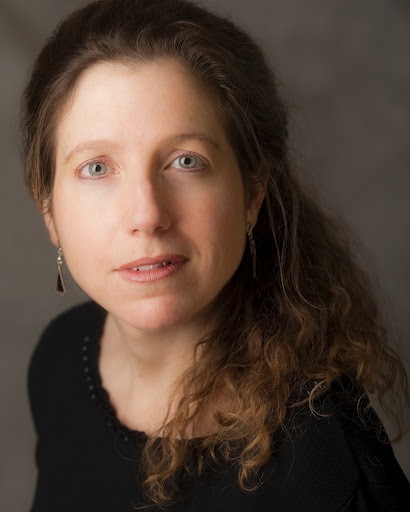The Well-Tempered Ear
From beginner to maestro — for the Final Forte, John DeMain reflects on a life in music
6 Comments
PLEASE HELP THE EAR. IF YOU LIKE A CERTAIN BLOG POST, SPREAD THE WORD. FORWARD A LINK TO IT OR, SHARE IT or TAG IT (not just “Like” it) ON FACEBOOK. Performers can use the extra exposure to draw potential audience members to an event. And you might even attract new readers and subscribers to the blog.
By Jacob Stockinger
This Wednesday night, March 6 at 7 p.m. in Overture Hall, is the “Final Forte” — the annual high school concerto competition with the Madison Symphony Orchestra under its longtime music director and conductor John DeMain (below, in a photo by Peter Rodgers).
You can attend the concert in person for FREE or watch it live on PBS Wisconsin or listen to it live on Wisconsin Public Radio.
For more details, go online to: https://madisonsymphony.org/education-community/education-programs/young-artist-competitions/the-final-forte/
As usual you can see and hear summary biographies of and impressive interviews with this year’s four teenage participants (below, in a photo by James Gill) and what they think of the competition. You can also read about the three judges and about past compeiutitons and the winners.
But this year, DeMain opened up about himself to PBS Wisconsin. He talks about why he likes and looks forward to directing the performances by young artists and what he thinks about starting a career in music.
DeMain — who will retire at the end of next season — also draws on his own award-winning career from his first piano lessons though his education at the Juilliard School, his lessons with Leonard Bernstein and his 30-year tenure at the MSO.
Trust The Ear — it is an engaging interview well worth reading for many reasons.
Here is a link to that interview:
Do you anything to say about how DeMain sees working with and encouraging young artists?
About his own career?
The Ear wants to hear.
Tags: Abe, Arts, audience, award-winning, Bach, Bernsteoin, biography, blog, Bolz, Bolz Young Artist Competition, career, Cello, Classical music, Competition, composer, concertmaster, concerto, conductor, Elgar, encourage, Facebook, Felix Mendelssohn, Final Forte, free, high school, in person, interview, Jacob Stockinger, Johann Sebastian Bach, John DeMain, judge, Juilliard, juror, jury, La Crosse, Lawrence University, Lawrence University Conservatory of Music, Leonard Bernstein, link, live, longtime, Madison, Madison Symphony Orchestra, Mendelssohn, Milwaukee Symphony Orchestra, Mozart, MSO, Music, Music director, Music education, music lessons, online, opera, Orchestra, Oregon, Overture Center, participant, PBS, PBS Wisconsin, percussion, Piano, piano lessons, Prism, professional, Radio, Retirement, Saint-Saens, share, Stevens Point, symphony, tag, Television, tenure, The Ear, trust, TV, United States, University of Wisconsin-Madison School of Music, Violin, Website, Wisconsin, wisconsin public radio, Wisconsin Public Television, Wolfgang Amadeus Mozart, WPR
Due to popular demand, Wisconsin Youth Symphony Orchestras (WYSO) opens its FREE virtual master classes to the public. Today features the violin and Monday features the bass
Leave a Comment
PLEASE HELP THE EAR. IF YOU LIKE A CERTAIN BLOG POST, SPREAD THE WORD. FORWARD A LINK TO IT OR, SHARE IT or TAG IT (not just “Like” it) ON FACEBOOK. Performers can use the extra exposure to draw potential audience members to an event. And you might even attract new readers and subscribers to the blog.
By Jacob Stockinger
The Wisconsin Youth Symphony Orchestras (WYSO) welcomes back two distinguished and successful alumni this weekend to teach the fifth and sixth master classes in an ongoing series that has already wowed observers. (WYSO alumni are noted below with an asterisk.)
Each virtual event is free and open to the general public with registration required in advance.
“The series has been so fabulous that, due to popular demand, we’ve opened up the events to anyone who wants to attend,” says Susan Gardels, marketing and communications director for WYSO.
TODAY – Sunday, Jan. 10 — from 5:30-7:30 p.m. CST Derek Powell, a violinist with the National Symphony Orchestra in Washington, D.C., will coach four WYSO violin members in a two-hour master class.
This will be followed the next evening with a master class coached by Scott Pingel, Principal Bass with the San Francisco Symphony Orchestra (Monday, Jan. 11, 6:30-8:30 p.m. CST).
A master class presents a one-on-one opportunity for a student musician to learn from a guest artist with an audience invited to observe the process.
In previous master classes in this series, the audience has learned instrument performance techniques and musical interpretation tips from a wide variety of guest artists who professionally play music around the world.
With the master classes presented in an intimate Zoom setting, the audience learns along with the student— and it is amazing to see the sudden growth in a student’s musical prowess as a master class proceeds.
Derek Powell’s bio includes his experience with the New World Symphony where Powell (below) performed as concertmaster with famed conductor Michael Tilson Thomas and as a violinist with the Army Strings, as well as his current experience with the National Symphony Orchestra.
Scott Pingel (below) was a trumpet player in his WYSO days with a side love for electric bass. Pingel switched to concert bass as an undergraduate at UW-Eau Claire, continued studies at the Manhattan School of Music, and played with the New World Symphony and the Charleston Symphony before joining the San Francisco Symphony as Principal Bass in 2004. He recently created buzz by playing with Metallica in a packed house with the San Francisco Orchestra.
For more information, go to: WYSO Amazing Masterclass Series:
Here are details and links to register:
*Derek Powell, Violin Master Class
TODAY, Sunday, Jan. 10, 5:30-7:30 p.m. CST
Free and open to the public
Click here to register in advance
_______________________________
*Scott Pingel, Bass Master Class
Monday, Jan. 11, 6:30-8:30 p.m. CST
Free and open to the public
Click here to register in advance
Here are is a schedule of future WYSO alumni master classes:
Katherine Steele (below), oboe
Sunday, Jan. 17, 6-8 p.m. CST
(Principal Oboe, Milwaukee Symphony Orchestra) https://wysomusic.org/katherine-steel-masterclass/
James Shields (below), clarinet
Sunday, Jan. 24, 7-9 p.m. CST
(Principal Clarinet, Oregon Symphony Orchestra)
Read more about James Shields
*Nancy Goeres (below), bassoon
Sunday, Feb. 7, 6-8 p.m. CST
(Principal Bassoon, Pittsburgh Symphony Orchestra)
Danbi Um (below), violin
Sunday, Feb. 21, Time TBD
(Soloist, member Chamber Music Society of Lincoln Center)
Megumi Kanda (below), trombone
Sunday, Feb. 28, 5:30-7:30 p.m. CST (Principal Trombone, Milwaukee Symphony Orchestra)
David Perry (below), violin
Sunday, March 7, 6-8 p.m. CST
(First Violin, UW-Madison Pro Arte Quartet and UW-Madison Music Professor)
Naha Greenholtz (below), violin
Sunday, March 28, 6-8 p.m. CST
(Concertmaster, Madison Symphony Orchestra and Quad Cities Symphony Orchestra)
*Sharan Leventhal (below), violin
Sunday, April 11, 6-8 p.m. CST
(Boston Conservatory)
For more information, go to https://wysomusic.org or call (608) 733-6283.
Tags: #African-Americanmusician, #ArmyStrings, #AugustaReadThomas, #BassPlayer, #BlackAmericans, #BlogPost, #BlogPosting, #BostonConservatory, #ChamberMusic, #ChamberMusicSocietyofLIncolnCenter, #CharlestonSymphony, #ClarinetMusic, #CommunicationsDirector, #ConcertBass, #DanbiUm, #DavidPerry, #DerekPowell, #ElectricBass, #FacebookPost, #FacebookPosting, #FacultyMember, #GeneralPublic, #GuestArtist, #HomeWebsite, #JacobStockinger, #JamesShields, #KatherineSteele, #LincolnCenter, #MadisonSymphonyOrchestra, #ManhattanSchoolofMusic, #MarketingDirector, #MeadWitterSchoolofMusic, #MegumiKanda, #MichaelTilsonThomas, #MilwaukeeSymphonyOrchestra, #MilwaukeeWisconsin, #MusicCoach, #MusicEducation, #Musicfaculty, #MusicProfessor, #NahaGreenholtz, #NancyGoeres, #NationalSymphony, #NationalSymphonyOrchestra, #NewWorldSymphony, #OboeMusic, #OnlineConcert, #OrchestralMusic, #OregonSymphonyOrchestra, #PittsburghSymphony, #PopularDemand, #PrincipalBass, #PrincipalBassoon, #PrincipalClarinet, #PrincipalOboe, #PrincipalTrombone, #ProArteQuartet, #QuadCitiesSymphonyOrchestra, #RegistrationForm, #RockandRoll, #SanFranciscoSymphony, #ScottPingel, #SharanLeventhal, #TheEar, #TheUW, #UniversityofWisconsin-Madison, #USArmy, #UW-EauClaire, #VirtualConcert, #WashingtonD.C., #WisconsinYouthSymphonyOrchestras, #YouTubevideo, #ZoomMeeting, advance, African American, alumni, alumnus, anyone, Army, Army Strings, Arts, asterisk, audience, bass, Bassoon, bio, black, blog, Boston Conservatory, buzz, call, Chamber music, Chamber Music Society of Lincoln Center, Charleston, Charleston Symphony, clarinet, Classical music, coach, communications, Concert, concert bass, concertmaster, conductor, current, D.C., Danbi Um, David Perry, demand, Derek Powell, details, director, distinguished, electric bass, evening, event, experience, Facebook, Facebook post, Facebook posting, faculty, forward, free, general public, go, guest artist, home website, information, instrument, invite, Jacob Stockinger, James Shields, Katherine Steele, learn, like, LIncoln Center, link, Love, Madison, Madison Symphony Orchestra, Manhattan School of Music, marketing, master class, masterclass, Mead Witter School of Music, Megumi Kanda, member, Mettalica, Michael Tilson Thomas, Milwaukee, Milwaukee Symphony Orchestra, Monday, MSO, MTT, Music, Music education, music faculty, Musician, Naha Greenholtz, Nancy Goeres, National Symphony, National Symphony Orchestra, New World Symphony, noted, Oboe, oboist, observe, observer, online, open, opportunity, Orchestra, orchestral music, Oregon, Oregon Symphony Orchestra, PAQ, performance, Pittsburgh Symphony Orchestra, play, popular, popular demand, post, posting, Principal Clarinet, Principal Oboe, Principal Trombone, prinicipal, Pro Arte Quartet, process, professor, prowess, public, Quad Cities, Quad Cities Symphony, registration, require, rock and roll, San Francisco Symphony, Scott Pingel, series, Sharan Leventhal, share, side, society, solo, soloist, Student, studies, successful, Sunday, switch, symphony, tag, technique, techniques, The Ear, Trombone, trombonist, U.S. Army, undergraduate, United States, University of Wisconsin-Madison School of Music, University of Wisconsin–Madison, UW, UW-Eau Claire, UW-Madison, Violin, violin music, violinist, virtual, Washington, Washington D.C., Website, weekend, welcome, Wisconsin, Wisconsin Youth Symhony Orchestras, wowed, WYSO, Zoom
Classical music: The Madison Symphony Orchestra opens its new season this weekend with music by Holst and photographs by NASA in “The Planets: An HD Odyssey”
2 Comments
By Jacob Stockinger
The Ear has received the following announcement from the Madison Symphony Orchestra:
The Madison Symphony Orchestra (MSO, below), with Music Director John DeMain conducting, opens its 91st season – and its 23rd season under Maestro DeMain — with three works by 20th-century composers.
Science, music and stunning visuals come together with Gustav Holst’s The Planets accompanied by a spectacular, high-definition film featuring NASA imagery. (Below is a photo of Jupiter, “The Bringer of Jollity” to Holst. The musical depiction of Jupiter — performed by James Levine conducting the Chicago Symphony Orchestra — is in the YouTube video at the bottom.
MSO’s Concertmaster Naha Greenholtz is featured in the Chaconne, a dramatic theme by John Corigliano, from The Red Violin film. The concert begins with George Enescu’s Romanian Rhapsody No. 1.
The concerts are in Overture Hall on this Friday., Sept. 23, at 7:30 p.m.; Saturday, Sept. 24, at 8 p.m.; and Sunday, Sept. 25, at 2:30 p.m.
A national hero in his homeland, Enescu rarely included hints of his Romanian heritage in his music, except when he composed the Romanian Rhapsodies as a teenager. Romanian Rhapsody No. 1 captures a series of Romanian folk songs, including melodies of increasingly wild Gypsy dances. This is MSO’s first performance of this work.
In the Chaconne, American composer John Corigliano (below) draws the audience in with a foreboding and haunting signature tune, which he wrote for the powerful film about music, The Red Violin. His film score for the movie earned him an Academy Award in 1999 for his original music. This will be the first time MSO has performed this Oscar-winning work, and features MSO Concertmaster Naha Greenholtz.
Greenholtz (below) has captivated audiences as Concertmaster of the MSO and the Quad City Symphony Orchestra. A Canadian violinist, Greenholtz was born in Kyoto, Japan, where she began her violin studies at age three.
Since her solo debut at 14, she continues to perform internationally, most notably with: the Oregon Symphony, Calgary Philharmonic, National Ballet of Canada, Omaha Symphony, and Memphis Symphony.
The Planets is known as Holst’s most popular work. The musical movements were inspired by characteristics connected with astrology’s seven planets. For instance, ominous sounding Mars, the Bringer of War, is followed by the calmly flowing Venus, the Bringer of Peace. (Below top is Mars and below bottom is Venus.)
The performances will be accompanied by a high-definition film projecting celestial images above the main stage.
According to New York Times senior critic Anthony Tommasini, the film shows “photographs from rovers and satellites, radar images and computer-generated graphics … combining to give the audience the impression of circling individual planets and sometimes flying over their awesomely barren landscapes.” (Below is a close-up of the surface of Mars.)
The Madison Symphony Women’s Chorus (below top, in a photo by Greg Anderson), under the direction of Beverly Taylor, will be part of the final movement of The Planets, and the Overture Concert Organ (below bottom) is featured at several moments in the piece.
This is the first time MSO’s performance of The Planets will be accompanied by the high-definition film.
One hour before each performance, Randal Swiggum, the artistic director of the Elgin Youth Symphony Orchestra Artistic, will lead a 30-minute Prelude Discussion in Overture Hall to enhance concertgoers’ understanding and listening experience.
For more background on the music, please view the Program Notes at: http://www.allsenmusic.com/NOTES/1617/1.Sep16.html or madisonsymphony.org/planets.
Before all of the concerts and at intermission, Friends of University of Wisconsin–Madison Astronomy will have an interactive display in the lobby concertgoers can experience.
The Symphony recommends that concert attendees arrive early for each performance to make sure they have time to pass through Overture Center’s security stations, and so they can experience the pre-concert talk and the astronomy exhibit (free for all ticket-holders).
Single Tickets are $16 to $87 each and are on sale now at madisonsymphony.org/planets, through the Overture Center Box Office at 201 State Street, or by calling the Box Office at (608) 258-4141.
Groups of 15 or more can save 25% by calling the MSO office at (608) 257-3734. For more information visit, madisonsymphony.org/groups.
Student rush tickets can be purchased in person on the day of the concert at the Overture Box Center Office at 201 State Street. Students must show a valid student ID and can receive up to two $12 or $15 tickets. More information is at: madisonsymphony.org/studentrush.
Seniors age 62 and up receive 20% savings on advance and day-of-concert ticket purchases in select areas of the hall.
Discounted seats are subject to availability, and discounts may not be combined.
Major funding for the September concerts is provided by: NBC15, Diane Ballweg, Capitol Lakes, Friends of University of Wisconsin–Madison Astronomy, The Gialamas Company, Inc., and Nicholas and Elaine Mischler. Additional funding is provided by: Analucia and Mark Allie, for their beloved “Doc” Richard Greiner; Judith and Nick Topitzes, and the Wisconsin Arts Board with funds from the State of Wisconsin and the National Endowment for the Arts.
Tags: 20th-century, Academy Award, America, Anthony Tommasini, Arts, astrology, astronomy, ballet, Calgary, Canada, Cello, chaconne, Chicago, Chicago Symphony Orchestra, choral music, chorus, Classical music, composer, computer, concertmaster, conductor, dance, Elgin, Enescu, film, Film score, Gustav Holst, gypsy, HD, High definition, Holst, imagery, Jacob Stockinger, James Levine, Japan, John Corigliano, John DeMain, Jupiter, Kyoto, landscape, Madison, Madison Symphony Orchestra, Maestro, Mars, melody, Memphis, movie, movie score, Music, NASA, National Endowment for the Arts, NEA, New York Times, Omaha, Orchestra, Oregon, organ, Oscar, Overture Center, photograph, planet, Prelude, program notes, Quad City, radar, Randal Swiggum, Red Violin, rhapsody, Romania, Roumania, Rumania, satellite, science, senior, Student, symphony, The Planets, United States, University of Wisconsin-Madison School of Music, University of Wisconsin–Madison, US, Venus, Viola, Violin, visual, vocal music, Wisconsin, Wisconsin Arts Board, women, Youth, YouTube
Classical music education: How do you capture sound in pictures? Photographer Michael R. Anderson talks about his images of musicians at the UW-Madison School of Music. His photos are on show at the Lowell Center through April 30. A public reception is this Sunday afternoon 1-3.
1 Comment
By Jacob Stockinger
If you go to the official website (http://www.music.wisc.edu) and the A Tempo blog (https://uwmadisonschoolofmusic.wordpress.com) of the University of Wisconsin-Madison School of Music — and you really should do so regularly if you are a classical music fan in the Madison area — you are likely to see a lot of photographs taken by Michael R. Anderson.
So who is he?
And what does he say about his photographs, which feature striking compositions and a fine sense of animation?
You can judge for yourself from the new exhibition of his images at the Lowell Center, 610 Langdon Street, phone (608) 256-2621. It went up last Sunday, but has its official opening and reception this Sunday afternoon — with refreshments and with the photographer present — from 1 to 3 p.m.
The free exhibit runs through April 30 at the UW-Extension Building At some future time, according to UW School of Music officials, some of Anderson’s images will be put on display outside Mills Hall and Morphy Hall.
For more information, visit:
http://www.music.wisc.edu/events/photo-exhibit-mike-anderson/
Michael R. Anderson (below) kindly spoke to The Ear about his photo show:
Can you briefly introduce yourself to readers and tell them about your personal and professional interests?
I was born and raised in Wisconsin and graduated from the University of Wisconsin-Madison in 1970 with a degree in Chemistry. After teaching for nine years, I returned to school, earned a Ph.D. in Environmental Science and Engineering and subsequently worked for the Oregon Department of Environmental Quality. When we retired, my wife and I returned to Wisconsin.
How and when did your interest in photography start and what drew you to music as a subject matter?
In 1966 I went to summer school in Germany. An aunt lent me her Kodak Instamatic to take with me. I was surprised to find how much I enjoyed trying to capture that summer in pictures. I’ve enjoyed photography as a hobby ever since. Since my wife and I like to camp and hike, landscape and nature photography is a favorite subject.
Our older son, Eric, is a UW-Madison School of Music graduate. He’s now the band director at Verona Area High School and he also conducts the Verona Area Concert Band. My first real attempt to photograph musicians was when he asked me to take pictures of the Concert Band for their website. That turned out to be more fun than I had anticipated, and I’ve photographed them several times over the past few years.
How did you get started taking pictures for the UW-Madison School of Music?
Kathy Esposito, who manages Public Relations for the School of Music, placed an ad in a local photography newsletter seeking a volunteer to take pictures that she could use to update the school’s website. One of the joys of retirement is having time to volunteer for jobs like this, so I contacted her.
Do you have favorite areas of interest or subject matter —portraits, action shots, rehearsals or performances, individuals or groups?
Candid shots of the musicians rehearsing or performing are my favorite, especially those of individuals or small groups. Trying to capture their energy, emotion and concentration as they play is an interesting challenge.
Do you see any parallels between photography and music?
They’re both food for the right side of the brain. Life would be rather boring without the arts to inspire us.
Do you care to share any technical information (camera, lenses, flash, processing software, printer, paper) for those who are interested?
Photographers like to say that the equipment is not important. Nevertheless, many people, even other photographers, are interested. All but one of the photos in this exhibit were taken on a Canon 7D with a Canon 70-200 f/4L or a Canon EF-S 17-85 f/4-5.6 lens. Lightroom and Photoshop were used to process the RAW files and the pictures were printed on Red River Polar Matte paper with an Epson Stylus Photo R2000 printer.
What do you most enjoy about making photos of music? What aspect do you least enjoy or find most challenging?
Photography gives me a chance to describe an aural experience with a visual language. That’s an interesting task. The difficult part is that classrooms are not photo studios with plenty of bright lights. I often have to use slower shutter speeds and higher ISOs (film speeds) than I would like.
How many images to you generally shoot during a typical concert to arrive at a “keeper” shot?
This can vary quite a bit, depending on the type of scene I’m trying to capture as well as the lighting and other factors. But it’s not unusual to take 10-20 photos to get one I like. One is never enough, of course, so it’s easy to take several hundred during a concert to get a selection of final images that cover various phases of the performance.
What else would you like to say?
These photos capture just a few moments in time but the music lives on through the excellent programs and performances at the UW-Madison School of Music.
If your readers have additional questions, there will be an open house for this exhibit at the Lowell Center (below), 610 Langdon St., on this coming Sunday, March 8, from 1 to 3 p.m. At 2 p.m. I will make a few comments about the exhibit and answer questions.
Tags: Arts, band, brass, Canon, Chamber music, chemistry, choral music, Classical music, conductor, engineering, environment, Germany, harp, high school, Horn, Jacob Stockinger, Lightroom, Madison, Music, Orchestra, Oregon, photo, photography, Photoshop, Piano, science, University of Wisconsin System, University of Wisconsin-Madison School of Music, University of Wisconsin–Madison, Verona, vocal music, Wisconsin
